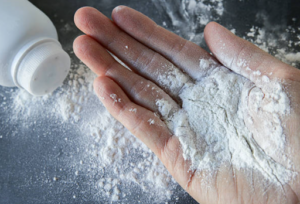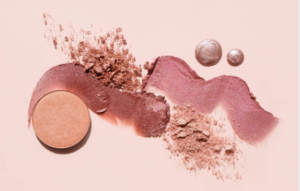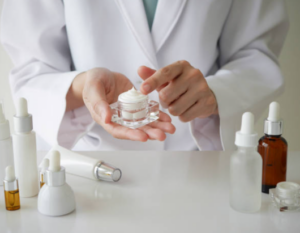From Mines to Makeup

Talc, a naturally occurring mineral, has been an integral part of beauty and personal care products for decades. Its soft texture and absorbent properties have made it a popular ingredient in products ranging from cosmetics to body powders. However, the journey of talc from mines to makeup is not without controversy. In recent years, concerns about talc’s safety and its potential link to health issues have sparked discussions and investigations. In this blog, we’ll delve into the origins of talc, its various uses in the beauty industry, and the ongoing debate regarding its impact on human health.
Talc, a silicate mineral with a soft, powdery texture, is formed through geological processes that span millions of years. Its origins can be traced back to metamorphic rocks, specifically those that undergo regional metamorphism. This process involves high temperature and pressure conditions that alter the mineral composition and structure of rocks, resulting in the creation of talc deposits.
The mineral talc is primarily composed of magnesium, silicon, and oxygen. It forms as a result of the alteration of other minerals, such as serpentine, pyroxenes, and amphiboles. These minerals undergo transformations due to geological forces, including the movement of tectonic plates, volcanic activity, and the interaction of minerals with hydrothermal fluids.
Talc is often found within metamorphic rock formations, particularly those rich in magnesium and low in aluminum content. It is commonly associated with rocks such as serpentinite, schist, and soapstone. These formations occur in a variety of geological settings, including mountain ranges, fault zones, and regions with ancient oceanic crust.
Talc mining involves the extraction of talc-containing rocks from the Earth’s crust. Once suitable deposits are identified, various methods are employed to extract the mineral. Open-pit mining and underground mining are two primary methods used to access talc deposits.
In open-pit mining, large machinery removes the overlying material, exposing the talc-containing rock underneath. The rock is then extracted, broken down into smaller pieces, and transported for further processing. Underground mining involves creating tunnels to access talc deposits that are located at deeper levels.
After extraction, talc undergoes a series of processes to refine it into the form that is used in cosmetic and personal care products. These processes include crushing, grinding, and milling, which reduce the talc rock into a fine powder. This powder can then be further refined through techniques like air classification to obtain the desired particle size and consistency.
Talc in Beauty and Personal Care Products
Talc’s versatility and desirable properties have made it a staple ingredient in a wide range of beauty and personal care products. Its unique characteristics, such as its softness, ability to absorb moisture, and smooth texture, have led to its incorporation into various cosmetic formulations. Let’s delve deeper into the ways talc is used in these products and the benefits it provides:
One of the most common applications of talc in the beauty industry is in powdered cosmetics. Products such as eyeshadows, blushes, and face powders often contain talc as a key ingredient. The use of talc in these formulations offers several advantages:
- Smooth Application: Talc’s fine particles contribute to a smooth and even application, allowing for effortless blending of colors on the skin.
- Matte Finish: Talc’s ability to absorb excess oil makes it an ideal choice for creating a matte finish in products like pressed powders and matte eyeshadows.
- Opacity and Pigmentation: Talc helps improve the opacity and pigmentation of color cosmetics, ensuring that the true color of the product appears on the skin.
- Longevity: Talc’s binding properties aid in the adherence of powdered cosmetics to the skin, extending their wear time.

Talc’s absorbent properties have also made it a popular ingredient in body powders. Body powders, often used to reduce friction, absorb excess moisture, and provide a fresh feeling, can contain talc for the following benefits:
- Moisture Absorption: Talc helps absorb excess moisture and sweat, making it a suitable ingredient for body powders used in areas prone to sweating, such as underarms and feet.
- Friction Reduction: The silky texture of talc contributes to reducing friction between the skin and clothing, preventing chafing and discomfort.
- Odor Control: Talc’s moisture-absorbing properties can contribute to reducing body odor by minimizing the conditions that bacteria thrive in.
While talc is more commonly associated with powdered cosmetics, it can also be found in some liquid and cream formulations. In liquid foundations and certain cream cosmetics, talc is added to enhance the texture and overall performance of the product:
- Texture Improvement: Talc can contribute to the smooth application and blending of liquid or cream products, ensuring an even and natural-looking finish.
- Oil Control: Talc’s oil-absorbing properties are utilized in products like liquid foundations to help control excess oil and shine on the skin.
- Mattifying Effect: When used in certain liquid formulations, talc can help create a mattifying effect on the skin, similar to its role in powdered cosmetics.
The Controversy: Talc and Health Concerns
The use of talc in beauty and personal care products has long been a subject of controversy due to concerns about its potential impact on human health. Central to this debate is the question of whether talc can be contaminated with asbestos, a naturally occurring mineral that has been linked to serious health conditions.
Asbestos is a group of naturally occurring minerals composed of fine, fibrous crystals. Inhalation of asbestos fibers is associated with serious respiratory diseases, including lung cancer, mesothelioma, and asbestosis. Given the severe health risks posed by asbestos exposure, it’s critical to understand its relationship to talc.
Talc deposits often share geological formations with asbestos deposits, leading to the possibility of cross-contamination during the mining and extraction processes. In its natural state, talc can contain traces of asbestos, which, if not rigorously removed, may find their way into cosmetic products and pose a potential health risk to consumers.
Beyond the asbestos concern, talc has also been scrutinized for a potential link to ovarian cancer. The debate centers around the use of talcum powder in the genital area and the hypothesis that talc particles might migrate to the ovaries, causing inflammation and potentially increasing the risk of cancer development.
Studies exploring this association have produced mixed results. Some epidemiological studies suggest a modestly increased risk of ovarian cancer with talc use, particularly with long-term and frequent use. However, other studies have found no significant link. As a result, the scientific community has not reached a consensus on the connection between talc use and ovarian cancer.
The controversy surrounding talc and its potential health risks has prompted significant responses from both the beauty industry and regulatory bodies. Addressing consumer concerns, ensuring product safety, and providing transparent information have been central to these responses.

Regulatory Oversight and Standards
Regulatory agencies, such as the U.S. Food and Drug Administration (FDA) and the European Commission, play a crucial role in setting and enforcing standards to ensure the safety of cosmetic products containing talc. These agencies have established specific guidelines to address concerns related to asbestos contamination and consumer health:
- Asbestos-Free Requirement: Cosmetic-grade talc must be tested and verified to be free of asbestos. This requirement aims to eliminate potential health risks associated with asbestos exposure.
- Thresholds and Limits: Regulatory guidelines define allowable limits for asbestos in cosmetic talc products. Manufacturers are required to adhere to these limits to ensure consumer safety.
- Labeling Requirements: Accurate and transparent labeling is mandated for cosmetic products containing talc. Ingredient lists must provide consumers with clear information about the presence of talc and other ingredients.
- Ongoing Monitoring: Regulatory agencies continuously monitor scientific research and data related to talc safety. They take necessary actions, including recalls, when products are found to pose potential health risks.
The beauty industry has also responded to concerns by implementing measures to prioritize consumer safety and transparency:
- Testing Protocols: Cosmetic companies have established rigorous testing protocols to verify the absence of asbestos in talc-containing products. These tests often involve sophisticated analytical techniques to ensure accurate results.
- Talc Sourcing: Many brands work closely with suppliers to source talc from mines that are rigorously tested and certified as asbestos-free.
- Alternative Ingredients: Some companies have proactively shifted away from using talc in their formulations, opting for talc-free alternatives like cornstarch, rice powder, or other natural ingredients.
- Consumer Education: Brands are committed to educating consumers about the safety measures they take, testing protocols, and their commitment to providing safe products.
Scientific research plays a vital role in shedding light on the potential health impacts of talc and informing regulatory decisions:
- Epidemiological Studies: Research studies continue to investigate the possible links between talc use and health conditions such as ovarian cancer. These studies involve large-scale analyses of data from diverse populations.
- Clinical Trials: Clinical trials are conducted to gather data on the effects of talc exposure and its potential health outcomes. These trials contribute to a deeper understanding of the relationship between talc and human health.
- Advancements in Testing: As technology advances, testing methods for detecting asbestos in talc are becoming increasingly sophisticated, enhancing accuracy and reliability.

The talc controversy underscores the importance of transparency in the beauty industry. Consumers have the right to know what ingredients are in the products they use and make informed choices based on reliable information. Brands that prioritize transparency and provide clear ingredient lists help consumers make educated decisions about the products they purchase.
Furthermore, ongoing research is essential to fully understand the potential health implications of talc use. Studies should continue to explore the links between talc and health conditions, while considering factors such as asbestos contamination, frequency of use, and application methods.
For those who wish to exercise caution when it comes to talc-containing products, here are a few tips:
- Check Ingredient Lists: Read the ingredient lists of cosmetics and personal care products to identify the presence of talc.
- Research Brands: Look for brands that prioritize transparency and provide detailed information about their sourcing, testing, and safety practices.
- Alternatives: If concerned, explore products that use talc alternatives like cornstarch.
- Stay Informed: Keep up-to-date with the latest research and regulatory information regarding talc and its safety.
The journey of talc from mines to makeup is marked by both its versatility and the ongoing debate about its safety. While the concerns are valid, regulatory agencies and the beauty industry have taken steps to ensure that talc-containing products are safe for consumers. Transparency, rigorous testing, and ongoing research will continue to play crucial roles in providing consumers with the information they need to make informed decisions about the products they choose to use.

